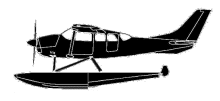
ASN Wikibase Occurrence # 190368
This information is added by users of ASN. Neither ASN nor the Flight Safety Foundation are responsible for the completeness or correctness of this information.
If you feel this information is incomplete or incorrect, you can submit corrected information.
| Date: | Sunday 25 September 2016 |
| Time: | 16:30 LT |
| Type: |  Cessna U206F Stationair |
| Owner/operator: | Private |
| Registration: | C-FWBQ |
| MSN: | U20602785 |
| Year of manufacture: | 1975 |
| Fatalities: | Fatalities: 2 / Occupants: 3 |
| Aircraft damage: | Destroyed |
| Category: | Accident |
| Location: | Mouchalagane River, Côte-Nord, QC -
 Canada Canada
|
| Phase: | Initial climb |
| Nature: | Private |
| Departure airport: | Lake Kuashkuapishiu, QC |
| Ra-Ma Lake, QC | |
| Investigating agency: | TSB |
| Confidence Rating: |
The day before the accident, the pilot flew from Gatineau Airport, Quebec, with 1 passenger aboard, to Kuashkuapishiu Lake, Quebec, where his hunting and fishing camp was located. The privately operated Cessna U206F floatplane stopped at the airport in Trois-Rivières, Quebec, to refuel and take on a second passenger. After dropping off the 2 passengers at Kuashkuapishiu Lake, the pilot made 3 more flights between Kuashkuapishiu Lake and Louise Lake, Quebec, to transport luggage and freight and to pick up 2 other passengers, who had arrived at Louise Lake by car, and bring them to Kuashkuapishiu Lake. The aircraft was refuelled twice between flights.
The pilot made a return flight to Louise Lake on the morning of the accident. The fuel transaction record from Louise Lake indicates that the pilot obtained 278 litres of aviation fuel at 1217 EDT. After returning to Kuashkuapishiu Lake, the pilot made pre-flight preparations to fly to Ra-Ma Lake, Quebec, with 2 passengers. The aircraft was loaded with food supplies, a 20-pound propane gas cylinder, 3 firearms, ammunition, an outboard motor and fuel, and luggage. One passenger was in the right-hand seat next to the pilot, and the other passenger was in the seat behind the pilot. The pilot gave a safety briefing that included a description of the seat belts, emergency exits, and lifejackets.
At around 14:00, the aircraft, equipped with Wipaire 4000A amphibious floats, left the dock and taxied over the water toward the south end of the lake. After warming up the engine, the pilot selected 20° of flap, raised the water rudders, turned the aircraft into the wind, and applied full throttle. The aircraft then began its takeoff run northwards and became airborne mid-course, about 1600 feet from the starting point. The aircraft began a climbing turn to the left when it reached the north end of the lake. The aircraft was then lower than the surrounding terrain, the elevation of which was 228 feet higher than the elevation of the lake.
A few moments later, the engine stopped and the pilot felt a reduction in the response to elevator and aileron control input, and at the same time noticed a 20-knot reduction in airspeed. The pilot decided to return to Kuashkuapishiu Lake and began a right turn by applying the right rudder pedal. The stall warning alarm then began sounding. The right wing dropped, and the aircraft nosedived.
The pilot pushed the control yoke forward. The aircraft lost altitude and crashed into a forested area a few metres from the lake tributary. An intense fire broke out immediately upon impact. Only the pilot, whose clothes were on fire, was able to escape from the wreckage and dive into the river.
No emergency locator transmitter (ELT) signal was received by the COSPAS-SARSAT satellite system, and no other aircraft in the area reported receiving an ELT signal. The post-impact fire completely destroyed the cabin of the aircraft.
Findings as to causes and contributing factors:
1. The coupling shaft of the engine-driven fuel pump sheared soon after takeoff while the engine was running at high speed, cutting off the engine's fuel supply and causing it to stop suddenly.
2. Because the engine failure occurred at low altitude, the pilot did not have time to identify the type of failure, recall the various relevant procedures, and take actions that could have restored engine power.
3. The pilot did not maintain glide speed, and the aircraft entered slow flight, just above the stall speed.
4. The pilot attempted a 180° turn at low altitude, and an aerodynamic stall ensued at too low an altitude for control to be regained before the aircraft struck the ground.
Accident investigation:
 |
|
Sources:
http://www.bst-tsb.gc.ca/eng/rapports-reports/aviation/2016/a16q0119/a16q0119.asp
___________________
http://www.martinsammodels.com/webpage/pages/Real%20Aviation/aircraft/aircraft/Cessna/206/Private/C-FWBQ/C-FWBQ.htm
https://www.flickr.com/photos/tsbcanada/29508909084/in/dateposted/
Images:

Photo: TSB
Revision history:
| Date/time | Contributor | Updates |
|---|---|---|
| 26-Sep-2016 06:19 | gerard57 | Added |
| 26-Sep-2016 06:20 | harro | Updated [Aircraft type, Location] |
| 26-Sep-2016 23:15 | Geno | Updated [Time, Aircraft type, Registration, Cn, Location, Source] |
| 01-Oct-2016 13:34 | Aerossurance | Updated [Time, Phase, Departure airport, Source, Narrative] |
| 05-Oct-2016 19:58 | Aerossurance | Updated [Source, Narrative] |
| 27-May-2017 14:35 | Iceman 29 | Updated [Source, Narrative] |
| 17-Nov-2017 13:17 | harro | Updated [Destination airport, Source, Narrative, Photo, ] |
Corrections or additions? ... Edit this accident description
The Aviation Safety Network is an exclusive service provided by:


 ©2024 Flight Safety Foundation
©2024 Flight Safety Foundation